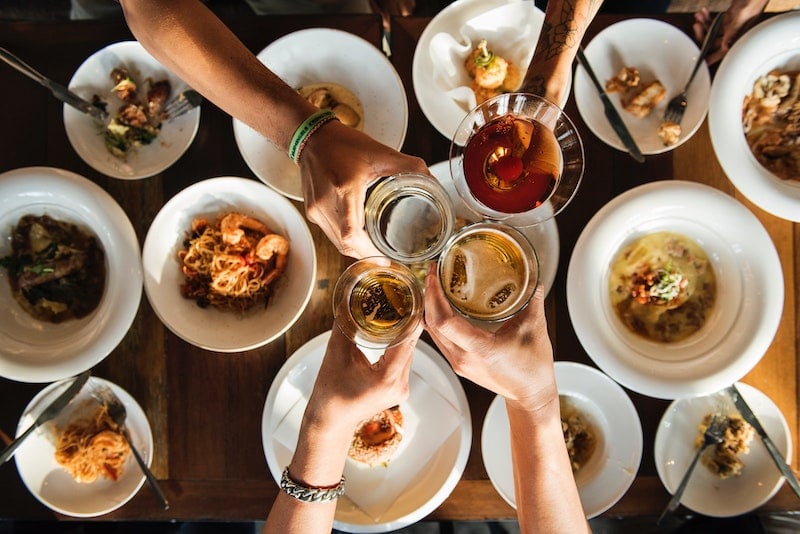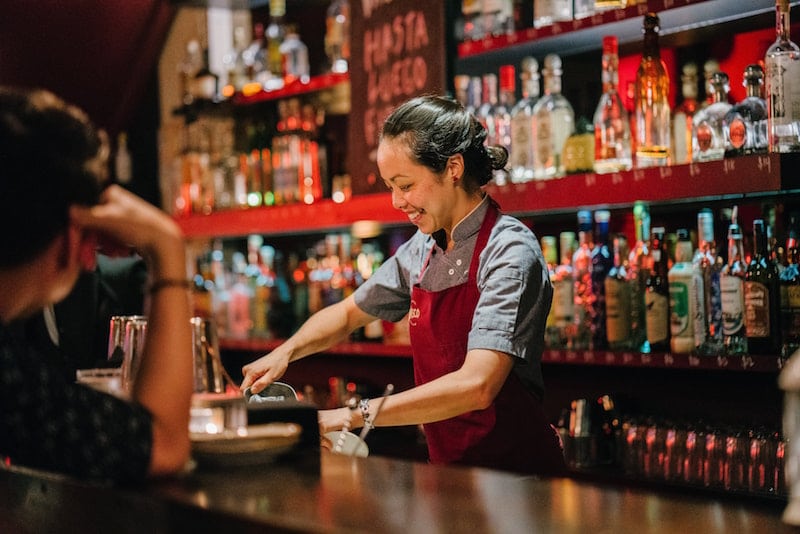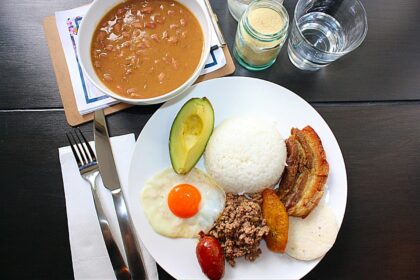By Margaret Hoeschele, Epicure & Culture contributor
French dining etiquette differs greatly when compared to the United States.
Just listen to this:
Since moving to France, I’ve learned that the USA and its people are go-to topics of conversation amongst my European and American friends alike.
The good, the bad, and the in-between are all fair game.
As a result, I’ve learned to have a set of anecdotes ready to pull from at a moments notice — a different perspective on topics like politics, culture, and other parts of the American lifestyle.
Given that the USA is often in the global spotlight, that might not come as a surprise to you.
But, what might surprise you is that one of my most popular fun facts — along with the cost of American dental work and the prominence of automatic cars — details the rules of American table service and restaurant etiquette.
Psst, don’t forget to pin this post for later!

Usually, I start by explaining the “first bite” rule.
This entails waitstaff returning to a table just after food is served, half the time before their first swallow, to see how they’re enjoying the meal.
My French companions stare at me in disbelief, especially when I continue sharing how servers in the USA are expected to check in on tables five, six, even seven times throughout a meal.
So, what’s the big deal?
The answer to this, in my own personal experience, is that France and many European countries follow a stricter and very different set of unspoken rules in their restaurants.
French culture, when it comes to dining out, is so different from its American counterpart that there are thousands of articles on Google detailing how to order in a French restaurant.
There are also hundreds of comments on TripAdvisor depicting unsuspecting Americans’ interactions with seemingly rude foreign staff, and even “spoof” videos on YouTube highlighting the shocking differences between these culinary worlds.
I think there are indeed different rules here for dining out in France vs the USA.
But, contrary to popular belief, these rules are not a bad thing.
The truth:
Though intimidating at first, once you get them down you’ll learn to love the way the French dine.
Now I had to learn these rules of etiquette the hard way — through trial and error.
Luckily, you don’t, since I’ve compiled a list of the most important things to know before entering that Parisian cafe, Provincial bistrot, or Alsatian winstub, so you truly understand dining etiquette when traveling in France.

1. French Dining Etiquette & Waiting To Be Seated
The quickest way to spot the Americans in a French restaurant?
Look for the people waiting by the front door!
This staple of American etiquette makes us stick out like a bunch of sore thumbs because this is something French people don’t usually do.
When you arrive at a restaurant or bar in France, as well as many other European countries, you won’t always have to wait for a table.
Often, you are welcome to take a seat at any free table — especially if the restaurant has an outdoor terrace.
When you enter a restaurant in #France vs the USA, here is one thing that is very different. #TravelTipsThen again, I’ve also taken this rule too seriously and waltzed over to a restaurant table only to be politely told that the table was reserved, so use your common sense.
Just don’t be surprised if it looks like the staff could care less where you sit.
The reality is they might not, so don’t be afraid to take a seat wherever you like and ask for a menu.
2. French Etiquette When It Comes To Drinks
Drinking in France follows a certain order:
It’s a well-organized ritual that has become one of my favorite parts of the local culinary culture.
One might start their meal with a little apéritif, or apéro, which is typically an alcoholic drink served before you begin eating. Or with hors d’oeuvres, to get your appetite going.
Drinks typically served at this part of the meal include wine, liquor, Champagne — or crémant d’Alsace, the Alsatian cousin of champagne that I’m lucky enough to have enjoyed on several occasions while eating in Strasbourg.
You might also find combinations of any of these drinks, as you would at a cocktail hour.
From there, you might switch things up for your meal.
Maybe you order a glass of red wine from Burgundy to go with your pasta, or some white wine from Alsace to go with fish.
The beautiful thing about France is nearly every wine you could possibly order will be delicious.
Plus, if you’re at a really nice restaurant, the staff might have recommendations about what to pair with your main meal, so feel free to ask if you’re not sure.
Finally, you can finish off your meal with a digestif — typically some kind of wine or brandy, or play it safe with a café noir (black coffee).
The bottom line:
Don’t be intimidated. Pour one out, and don’t forget to cheers!
3. Saying Cheers In France
Cheers-ing in France is a more significant and more superstitious ritual than in the United States.
First of all, make sure to clink everyone with a full glass and direct eye contact — or else risk seven years of relationship problems.
Additionally, never cross your arm over someone else’s as you reach across the table.

4. Understanding French Bread
Everyone knows that French bread is one of the most wonderful things on this planet — and if you don’t, I would recommend making a French boulangerie your first stop during a trip to France.
There is a reason we always picture a French person running around armed with several iconic baguettes, because when the bread is this good who wouldn’t go out of their way to eat it with every meal?
When eating out in France, you’ll often be given a bowl of this beautiful baked good to accompany your meal, though you might be surprised to see it show up on your table with no butter in sight.
In #France, bread is not eaten as a pre-dinner snack. Here is how the locals enjoy it instead. #TravelTipsThis is because the bread isn’t meant to be a before-dinner snack. Instead, it’s often eaten with dinner or at the end of the meal.
The only thing better than sopping up whatever is left on your plate with a nice hunk of baguette is pairing said baguette with a hunk of French comté, a delicious semi-hard cheese made from unpasteurized cow’s milk.
5. No Doggy Bags In France
I like to think of the French as enthusiastic members of the clean plate club.
This rule seems to apply to restaurants and family homes alike.
I’ve, at one point in my life, chosen to consume my entire body weight in tortellini rather than risk offending an older French friend who cooked dinner for me.
When you’re finished with your meal in France, it’s rare that your server will think to ask if you want to take home your leftovers.
Also, keep in mind that portion sizes at French restaurants are typically smaller than they would be in the USA, so it’s easier to finish your food.
Since moving to France there have been a few times I have failed to finish a dish at a restaurant. In these instances, rather than being asked if I wanted to take home what was left, I was asked what was wrong with the dish, in case the server needed to tell the chef.
So, if you can’t eat another bite but can’t stand to part with your bouillabaisse, bœuf bourguignon or coq au vin, you can always ask the waiter if you can take the rest à emporter, or to-go.
Just remember this is uncommon, so don’t be surprised if they have difficulty accommodating.
6. Tipping In France
When it comes to tipping in France, keep in mind that while restaurant workers in the USA typically rely on tips to make a decent salary, French restaurant staff often make a livable wage without tips.
As a result, French servers may not respond to customers with the same enthusiasm as American servers might.
They also don’t need to keep customers cycling in and out in order to make enough pocket money at the end of their shift — which is what the next tip on restaurant etiquette in France, below, is about.
Because of this, French servers might not feel the same obligation to make service a positive social interaction.
Rather, a server is just there to provide you with good service.
Here is how #France and the USA differ when it comes to tipping in restaurants. #TravelTipsSo, you need not feel obligated to tip here.
Still, I think the reputation French servers have for being cold or inattentive is, for the most part, inaccurate and not well-deserved.
The bottom line:
Most French restaurant staff are perfectly pleasant and attentive to customers, with or without a tip to entice them.
So when this happens to you — as it most often does — it’s perfectly acceptable to throw a few extra Euros their way as a pourboire to show your appreciation.
7. Table Turnover In French Restaurants
I don’t know about you, but when I think of France, the first image that comes to mind is that of a beret-sporting Frenchman drinking espresso and reading a book for hours on end in some picturesque Parisian cafe.
This image is, in fact, pretty common in France, but you’d be hard-pressed to find the same thing in an American restaurant.
The reason?
Table turnover.
Just like French servers don’t rely on tips to supplement their earnings, they don’t rely on getting new customers in the door and old customers out the door to make ends meet.
This means that you don’t need to be rushed out when you take up occupancy in a French restaurant or cafe.
In fact, I’ve seen people spend hours at a table just nursing drinks at the end of a meal, though this might be a bit of an extreme.
This is also why you’re unlikely to find your waiter prepping your bill the minute you’ve finished your entrée.
To you, this might seem like poor service, but to your waiter, it might be rude to do otherwise.
If you’re pressed for time, you can signal the waiter, or ask for l’addition.
Otherwise, feel free to stay a bit longer at your table, because enjoying several courses, plus coffee and dessert, is a part of the French culinary experience.
8. The Customer is Not Always Right In France
In my experience, the biggest difference between French restaurants and eateries in the United States is that the French focus on the cuisine, while the American focus on the customer.
Americans might see French restaurant staff as unwilling to accommodate customer needs, because visitors from the USA are used to switching, changing, adding, customizing, and modifying with no problem.
It’s true that I have had restaurants reluctant to accommodate me as a vegetarian, or servers confused by my requests to split things with friends.
Which of these French dining rules did you already know? #France #FrenchFoodSo, while you won’t find that staff are able to respond to every single request or dietary need at the drop of a hat, when the original dishes are perfected to this level, you can’t blame them.
And, hey, if you ask nicely or call ahead, you’ll most likely find restaurants are willing to accommodate you, with some time to prepare.

The bottom line:
The French way of eating is a beautiful thing, though different from that of Americans.
France is often considered the culinary capital of the world, and dining here, both in restaurants and at home, mirrors this.
Dining in France is more than just a daily exercise. It’s a culinary experience, and most French people seem to feel that if a meal is worth doing, it’s worth doing right.
So when you find yourself faced with a culinary culture that’s different from what you’re used to, I’ve found its best to close your eyes, embrace unfamiliarity, and allow yourself to be immersed in a buttery, cheesy, wine-filled world unlike what you’d find anywhere else.
Do you have a French dining etiquette tip to add? Please share in the comments below!
Further Exploration:
French Baking: How To Make Croissants With Puff Pastry (Recipe Included) [From The Blog]
My Paris Kitchen: Recipes & Stories [Delicious Reads]
French Pastry 101: Classic Baking with 60 Beginner-Friendly Recipes [French Baking]
*This post contains affiliate links, which means if a purchase is made we make a commission at no additional cost to you.
Enjoyed this post? Pin it for later!









Hey Thanks for posting! I really enjoy your blog posts. –
YouTube SEO, T10 Cricket, Hebbe Falls
Thanks, I’m glad to hear it!
Thanks for these tips for dinner in France. They’ll be useful for my next trip.
Great, be sure to update on how things work out! Bon voyage.
There is definitely a lot to learn about this issue. I like all of the points you made.Thermofoil cabinet doors Vancouver
I’m glad you enjoyed Wally!
Thanks for sharing this blog! I must consider these tips very useful while planning a trip to France.